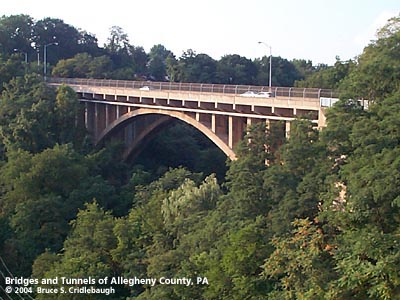| Home > All By Location regional map > Pittsburgh West > Ohio River Boulevard over Verner Av | |||
|
|

View northwest from Mckees Rocks Bridge More detail photos OFFICIAL NAME: OTHER DESIGNATION: Ohio River Boulevard over Verner Av LOCATION: Pittsburgh USGS 7.5" Topo Quad - UTM Coordinates: Pittsburgh West - Zone 17; 0581 4480 CARRIES: Ohio River Boulevard [PA65] BETWEEN: -- Millerton Av -- Termon Avenue Approach CROSSES: -- Verner Av TYPE OF CONSTRUCTION / DESIGN: Deck open spandrel concrete arch LENGTH OF MAIN SPAN: 210 ft TOTAL LENGTH (including longest elevated ramp): 390 ft HEIGHT OF DECK: 80 ft est YEAR ERECTED / ENGINEER: 1930, Allegheny County ADDITIONAL INFO: Mounted on the fence at the southwestern end of the bridge:
from the PennDOT Historic Bridges Survey "The bridge carries the 4 lane, Ohio River Boulevard (SR 65) over Verner Avenue in a wooded setting that gives way to modern, franchise commercial development and scattered highly altered early-20th century buildings. It was built as part of the Ohio River Boulevard, the highway designed to speed traffic to the McKees Rocks bridge. The highway has lost integrity due to alterations to its original geometry and roadside features as well as extensive modern development along it. Neither the highway nor the setting have historic district potential. FIELD CHECKED: 17-Aug-2004 INFO SOURCES: field check, PennDOT Historic Bridges Survey Submit info or inquiry - share some facts or ask a question. Introduction -- Nearby Structures Page created: Last modified: 14-Oct-2004 |
View Larger Map View Larger Map View Larger Map 
| |
| copyright: © Bruce S. Cridlebaugh 1999-2008 All Rights Reserved | |||